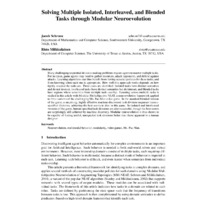Solving Multiple Isolated, Interleaved, and Blended Tasks through Modular Neuroevolution
Item
-
Title
Solving Multiple Isolated, Interleaved, and Blended Tasks through Modular Neuroevolution
-
Description
This is an Accepted Manuscript of an article. Schrum, J., & Miikkulainen, R. (2016). Solving Multiple Isolated, Interleaved, and Blended Tasks through Modular Neuroevolution. Evolutionary Computation, 24(3), 459–490. https://doi.org/10.1162/EVCO_a_00181
-
Creator
Schrum, Jacob
Miikkulainen, Risto
-
Identifier
Schrum, J., & Miikkulainen, R. (2016). Solving Multiple Isolated, Interleaved, and Blended Tasks through Modular Neuroevolution. Evolutionary Computation, 24(3), 459–490. https://doi.org/10.1162/EVCO_a_00181
-
uri
https://collections.southwestern.edu/s/suscholar/item/226
-
Abstract
Many challenging sequential decision-making problems require agents to master multiple tasks. For instance, game agents may need to gather resources, attack opponents, and defend against attacks. Learning algorithms can thus benefit from having separate policies for these tasks, and from knowing when each one is appropriate. How well this approach works depends on how tightly coupled the tasks are. Three cases are identified: Isolated tasks have distinct semantics and do not interact, interleaved tasks have distinct semantics but do interact, and blended tasks have regions where semantics from multiple tasks overlap. Learning across multiple tasks is studied in this article with Modular Multiobjective NEAT, a neuroevolution framework applied to three variants of the challenging Ms. Pac-Man video game. In the standard blended version of the game, a surprising, highly effective machine-discovered task division surpasses human-specified divisions, achieving the best scores to date in this game. In isolated and interleaved versions of the game, human-specified task divisions are also successful, though the best scores are surprisingly still achieved by machine discovery. Modular neuroevolution is thus shown to be capable of finding useful, unexpected task divisions better than those apparent to a human designer.
-
Subject
Neuroevolution
Multimodal Behavior
Video games
Modularity
 schrum.ecj16.pdf
schrum.ecj16.pdf